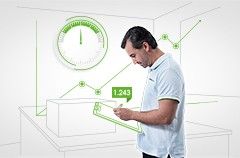
pH Accessories for Meters and Sensors
Ergonomic Electrode Arms, Magnetic Stirrers, Printers, Scanners and More
pH accessories are peripherals that are added to a pH meter to enhance it, increasing efficiency and customizing it for specific needs. Add an item from our range of pH accessories to simplify workflows, reduce error risks, and facilitate achieving the desired accuracy. Each meter has interfaces that allow for the connection of multiple pH accessories and peripherals, such as printers to document results, barcodes for sample identification, or stirrers to mix your sample while measuring.
Advantages of METTLER TOLEDO's pH Accessories

Print Your Results
METTLER TOLEDO offers a selection of printers to support your meter. These compact printer models are easily connected via USB or RS, and print results for audit-proof documentation.

Avoid Transcription Errors
The barcode reader automatically reads sample IDs, saving time and avoiding transcription errors with fast, secure identification that helps create complete metadata.
Export Your Data
Create pdf reports or store your data in other formats for further analysis. Depending on your security and automation needs, our meters allow you to export data onto a USB memory stick, the EasyDirect™ pH PC software, or LabX™ pH software. Read more

Reduce pH Errors with a Stirrer
Gentle stirring of a sample solution can help eliminate potential liquid junction errors. With an optional magnetic stirrer, the meter controls the stirring time and speeds. This helps to ensure sample homogeneity and reduces pH measurement errors.

Position Your Sensor Precisely
An ergonomic electrode arm moves vertically with precision and can be operated single-handedly. This allows for faster measurements and reduces the risk of sensor damage or sample vessel tipping.

Connect Quickly and Securely
LogStraight™ is a useful addition to your pH meter accessory toolkit. It is a biometric fingerprint reader that takes the hassle out of entering passwords. Simply place your finger on the reader, and the instrument recognizes you immediately.
Accessories for Accuracy on the Go
The uGo™ carrying case provides robust protection when performing regular measurements outdoors with the Seven2Go™ portable meter. The addition of a specialized rubber holster offers additional protection against accidental drops, dirt, chemicals, and UV light. Read more
Explore Our Services - Tailored to Fit Your Equipment
We support and service your measurement equipment through its entire life-cycle, from installation to preventive maintenance and calibration to equipment repair.
Support & Repair

FAQs
What are the pH accessories used for?
The addition of pH accessories to the electrochemistry system enhances and customizes the measurement process. METTLER TOLEDO offers printers, electrode arms, modular expansion units, and stirrers as pH accessories. pH accessories are available for both benchtop and portable pH meters for use in the lab or the field.
Which pH accessories help increase data security?
Accessories for enhanced data security include printers, barcode readers, and data export capabilities. Printers provide an easy way to document measurement results on paper. Barcode readers reduce potential errors during transcription, and various meters support PDF format export onto a USB memory stick.
What are the benefits of an electrode arm?
Correct sensor positioning is key to a correct sample reading. Holding the sensor by hand can be an option, however, an electrode arm offers several benefits. Precise positioning and a perfect vertical move make handling easier and prevent sensor damage or sample vessel tipping. If you plan to use multiple sensors, the electrode arm should be able to hold them either in measuring or storage positions.
Why is using a magnetic stirrer important?
Stirring is essential for reproducible results in measurements of pH, conductivity, and ion concentration. Investing in a magnetic stirrer generates several key advantages: programming of the desired stirring behavior as part of the measurement method, or the option to add pre-stirring and wait periods. Calibration and measurement must be done under the same conditions.
Which printers can be used with the SevenExcellence™ meter?
Three types of printers can be used with SevenExcellence™:
- Network printers: the content of the printout is the same that you get when creating a PDF file on a USB memory stick. It is not possible to connect a standard PC printer to SevenExcellence directly, only via Ethernet connection.
- USB compact printer, e.g. the USB-P25 printer: the same information as on a PDF file is printed, but in a more compact format.
- RS compact printers, e.g. RS-P25 or RS-P26: same print-out content as with USB compact printer, but via RS232.










